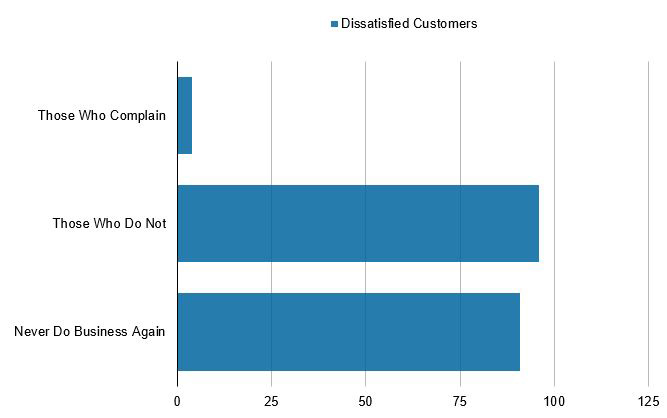
5 Ways to Keep Customers From Jumping Ship
You are a leader in your field. Everything you do is top-of-the-line, and you offer the highest level of service. Your customers are happy. Everything seems to be going well, and your business will continue to be successful. Or will it?
In today’s competitive world, it’s easy for your customers to search out and connect with new vendors any place and any time. That means you should be watching out to make sure they’re not thinking about moving their business elsewhere. In addition, you have to ensure that your clients aren’t considering taking advantage of offers from competitors trying to attract new business.
After all, according to a study conducted by The White House Office of Consumer Affairs as reported by Salesforce.com, it is six to seven times more expensive to acquire a new customer than it is to keep a current one. You simply can’t afford to lose good-paying clients. They’re too difficult — and costly — to replace.
Did you know: According to a survey done by American Express, 81 percent of Americans agree that small to mid-size companies place a greater emphasis on customer service than large businesses. That means these companies can differentiate themselves from larger competitors and win over new customers by offering great service.
Here are five things you can do right now to nurture and improve your customer relationships so you don’t lose valuable clients.
1. Communicate

It might seem obvious that you need to communicate regularly with your clients, but you’d be surprised how many businesses forget to do this. Once a business relationship is up and running, it’s easy to take it for granted. Business owners or sales reps naturally assume that all is going well if they don’t get a complaint. But that’s probably not the case.
Believe it or not: According to a study by Lee Resources, a business management consultant, as reported by Help Scout:
80% of companies say they deliver superior customer service – and only 8% of people think these same companies actually deliver it.
So how do you know you’re actually delivering great customer service if you don’t ask your customers?
Make it a point to regularly talk to your clients. Instead of sending them an email or text to ask a question or resolve a simple issue, pick up the phone instead. Use it as an excuse to check in on how things are going. Ask specific questions about quality, deliveries, and experiences with your workers.
These conversations could get your clients talking about little issues they may have not taken the time to call about. It may be small things, but fixing them will create a better client relationship over the long run.
TIP: Always have a good reason for calling a client. Customers could find calls for “no reason” irritating and a waste of their time.
Case study: John runs a mining supply company in Texas. Client contact is critical to his firm because the competition in his area is cut-throat. He, or someone from his sales team, tries to check in with their mining clients at least twice a month. One week, he noticed a pattern in many of his calls: clients mentioned that deliveries were arriving at inconvenient times. His sales team was hearing the same thing.
They checked in with the shipping department and found that it had changed shipping and delivery schedules without discussing the matter with their clients. The company returned to the old delivery schedule, avoiding a potential customer service issue before it happened.
2. Make it easy for customers to complain
You can’t call each customer every single day. So what happens on the day when a customer has a bad experience and you haven’t talked to them?
Make it easy for them to report the issue. Have a complaint area on your website that explains what customers should do if they run into a problem with a service you offer. Publish the name of the person they should contact, along with their phone number and email address.
And don’t just do lip service when it comes to customer-related issues. Have procedures in place to make sure they get resolved after they’ve been reported. Also, always remember to get back to the client to report the resolution. After all, according to a study by Lee Resources as reported by Customer Service Magazine, if you resolve a complaint in the customer’s favor, they will do business with you again 70 percent of the time.
Constantly remind your customers that feedback is important to you. Put messages on your website requesting it. Add it to all your bills and sales receipts. Include it as part of your on-hold messaging. Your clients must be aware that you are sincere about wanting to hear about their issues, and you have to be clear about how they can do that. Alan Weiss, an author and consultant, recommends that you “ask your customers to be part of the solution, and don’t view them as part of the problem.”
These reminders are important. A study by Ruby Newell-Legner as reported by Help Scout states that only four percent of dissatisfied customers actually take time to complain and 96 percent do not. Of those who do not complain, 91 percent never do business with the company again. Taking steps to encourage customers to complain could keep you from losing clients. In addition, for the unhappy customers who continue to work with you, it can take a lot to make up for an unresolved service issue.
According to Ms. Newell-Legner:
It can require 12 positive customer experiences to make up for just 1 unresolved negative experience.
Something to consider: “When customers share their story, they’re not just sharing pain points. They’re actually teaching you how to make your product, service, and business better. Your customer service organization should be designed to efficiently communicate those issues.”
– Kristin Smaby, “Being Human is Good Business”
3. Use social media to communicate — and listen — more
Most businesses think of social media as a communication device. However, in addition to talking to your customers, social media gives your customers a chance to talk to you.
Maintain an active social media platform — perhaps publishing and distributing company news and helpful electronics industry information through Facebook, Twitter, or LinkedIn — to remind your customers that you’re accessible. Give them a chance to post positive and negative comments through social.
Make sure you check your social media accounts regularly and respond to positive comments and complaints in a timely basis. Publicly responding to social complaints is a good practice because it demonstrates that you care about your customers. According to a study by Bain & Company, when companies engage and respond to customer service requests over social media, those customers end up spending 20 percent to 40 percent more money with the company. And it can keep issues from escalating. Nothing is worse than a negative social comment sitting unanswered for months.

Did you know: According to Touch Agency:
Over one million people view tweets about customer service every week – and roughly 80% of them are negative or critical in nature.
Case study: Marcy manages a business that supports events at concert venues. She started a Facebook page for the business a couple of years ago to connect with bands and concert promoters. She got busy and forgot to check the Facebook page for a few months.
When she finally got back online, she found that an unhappy ex-client had been posting negative comments to the page almost weekly. She feels devastated that potential clients who were checking out her business could have seen these comments.
She finally resolved the issue and cleaned up the page. She’s made a vow to actively manage her Facebook page and check for comments every day.
Great insight: “People want this level of engagement from the companies with which they do business … even the best of what formerly passed for good customer service is no longer enough.”
“You have to be no less than a customer concierge, doing everything you can to make every one of your customers feel acknowledged, appreciated, and heard. You have to make them feel special, just like when your great-grandmother walked into Butcher Bob’s shop or bought her new hat, and you need to make people who aren’t your customers wish they were. Social media gives businesses the tools to do that for the first time in a scalable way.”
— Gary Vaynerchuk “The Thank You Economy”
4. Ask for ratings and reviews
Requesting a rating or review is a great opportunity to be proactive. Today, it’s easy for customers to find plenty of outlets to provide ratings and reviews of your business — and if they’re angry or displeased with your service, they likely will.
According to David Pogue in an article in Scientific American, “The rise of the citizen review site is a sobering development. No longer are you on top of the mountain, blasting your marketing message down to the masses through your megaphone. All of a sudden, the masses are conversing with one another. If your service or product isn’t any good, they’ll out you.”
Did you know: According to a survey conducted by American Express:
Americans tell an average of 9 people about good experiences. They tell 16 (nearly 2x more) people about poor experiences.
Why not own part of that conversation and give your customers an opportunity to provide ratings and reviews on your own website? If you do this, they’ll be less likely to blast you on a more public, external review site. In addition, knowing what’s being said about your company online allows you to see where you’re succeeding and where you need improvement. It’s a great way to get ahead of problems and solve them before they become major issues.
Interesting statistic: According to the Pew Research Center’s Internet and American Life Project, 24 percent of American adults have posted comments or reviews online about the product or services they buy.
Worth considering: “Unfiltered feedback from customers is a positive even when it’s negative. A bad or so-so online review can actually help you because it gives customers certainty that the opinion is unbiased.”
— Gail Goodman, Entrepreneur, 2011
5. Be human
While your company may gather customer compliments and complaints using social media, email, websites, online reviews, and surveys, the response to feedback through these impersonal channels must be human and very personal.
Customers these days expect fast and accurate responses to customer issues. Identify a single point of contact to handle these communications from your company, or have your sales team — or the client’s everyday point of contact — take care of these issues.
Set a goal of responding to complaints within an hour or as close as possible to that mark. Make sure customer-related issues are handled in-person or over the phone. And double-check to see that they’re resolved to the customer’s satisfaction.
Only use impersonal channels like email and social media to follow up on personal conversations and to close the loop on a complaint. It’s not smart to get into a customer dialogue via social media, but it’s critical that a customer complaint raised in social is closed out in it.
Remember: “In an era when companies see online support as a way to shield themselves from ‘costly’ interactions with their customers, it’s time to consider an entirely different approach: building human-centric customer service through great people and clever technology. So get to know your customers. Humanize them. Humanize yourself. It’s worth it.”
— Kristin Smaby, “Being Human is Good Business”
In conclusion
You’ve worked hard to build your business. You can’t afford to jeopardize your success by ignoring customer service issues. Take steps today to ensure that you’re addressing your customers’ needs and handling any product or service issues. After all, you can’t afford to lose even one customer you worked so hard to build a relationship with.

 CALL OR TEXT NOW 800-597-9311
CALL OR TEXT NOW 800-597-9311

Leave a comment